"Arabushi"
"Arabushi" is a cleaned, boiled, dried and smoked "Katsuo" fillet. Its "Dashi" has the strong and distinct "dried and smoked" lingering aroma, and the deep and slightly acidic flavor. No mold is applied on "Arabushi".
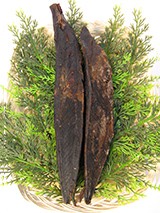
"Arabushi" is a cleaned, boiled, dried and smoked "Katsuo" fillet. Its "Dashi" has the strong and distinct "dried and smoked" lingering aroma, and the deep and slightly acidic flavor. No mold is applied on "Arabushi".
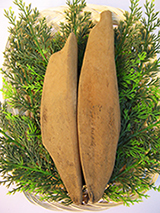
"Karebushi" is made by shaving off the fat from the surface of "Arabushi" and repeating the "apply the mold then dry" process several times. With the mold to further enhance its flavor, "Karebushi" creates this aromatic, elegant and round flavored "Dashi".
MAKURAZAKI HONKAREBUSHI, the finest of all "Karebushi", can create the most exquisite "Dashi" and it is because of its flavor balance. Chefs around the world rave it because its richness, flavor, bitterness and acidity perfectly play in harmony.
Shaving styles change Katsuobushi's flavor, aroma and how it melts in the mouth. The shaving type should be chosen based on how the "Katsuobushi" is used in cooking. "Katsuobusi" shaved in various shapes and sizes is often collectively referred as "Kezuribushi".
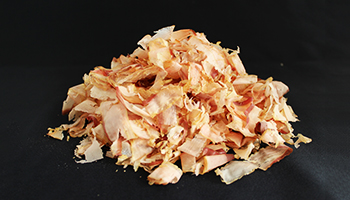
Shaved into thin pieces under 0.2mm thickness.
Flavors can be extracted quickly, so the delicate and elegant aroma is not lost.
It also can be used as a garnish.
Inspiration from the French cuisine:
Ingredients and Sauce for the Flan
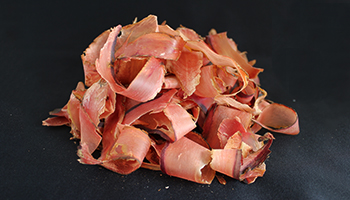
Shaved into thick pieces over 0.2mm thickness.
It is often used when making a braise with fully seasoned rich flavored "Dashi".
Inspiration from the French cuisine:
Pickles and Ingredients for the seafood pasta
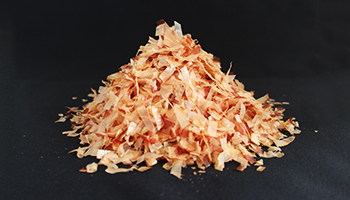
Shaved vertically to cut against the grain.
It brings out the flavor of simple ingredients because of its tender texture, "melts in mouth" experience and full flavor.
Inspiration from the French cuisine:
Ingredients for Risotto, and dough for Beignet
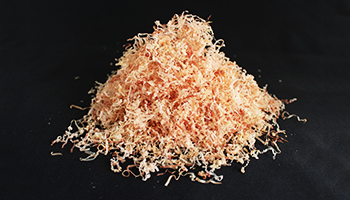
Shaved into string-like thin long pieces.
It is often used as a garnish because of its beautiful and delicate look.
Inspiration from the French cuisine:
Sprinkled over Gratin and Seafood Tartar (Snapper or Flounder)
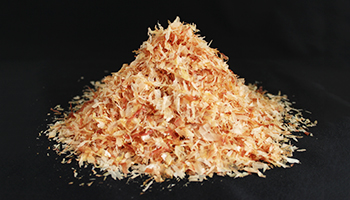
It is cracked "Usukezuri". Shaved parallel to the grains then crush into small pieces.
The aroma and flavor can be extracted quickly and it brings out the bold flavor. Because it is broken into pieces, it is also suitable to be used as seasoning or to add flavor to the ingredients.
Inspiration from the French cuisine:
Ingredients for Quenelle
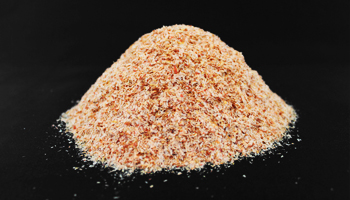
Cracked pieces are grinded into finer pieces to powder. This is used as an ingredient for cooking or flavoring as seasoning.
Inspiration from the French cuisine:
Seasoning of dressing and mixing into Tapenade
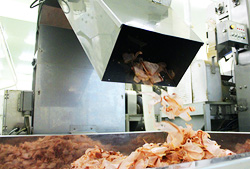
Flavor of "Katsuobushi" changes based on the shave style. Various tools are used to shave in many ways in order to bring out its delicate flavors.
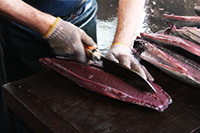
In a carefully controlled hygiene workplace, professionals skillfully work with several knives to cut off its head, and remove its gut and fins. Fish is cut into 4 filets called "Obushi" and "Mebushi"
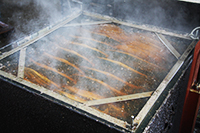
The fillets of "Katsuo" is placed in a metal basket called "Nikago". This critical stage is handled with extra care because this largely affects its final shape. The fillets are simmered for a few hours. Protein found in fillets are completely coagulated and water found in muscles is distributed in this process. This makes the premium and flavor-rich "Katsuobushi".
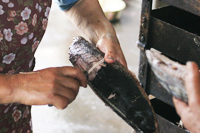
Manually remove bones and skins carefully without damaging the fillets.
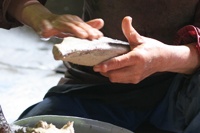
Fish paste is applied on each fillet to fill in cracks and lines for a perfect finish. This also helps distribute water in fish to create the beautiful "Katsuobushi".
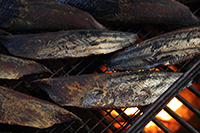
Then the drying starts. "Katsuo" fillets are smoked repeatedly with hard woods, such as oak. Depending on size of filets, smoking and the moisture removing process called "Anjo" are repeated 6 to 15 times. That process is repeated for 2 weeks to a month until the water is distributed equally in fillet and its water content is reduced to 23%. This is called "Arabushi".
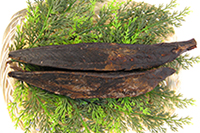 The process up to this point makes "Arabushi"
The process up to this point makes "Arabushi"
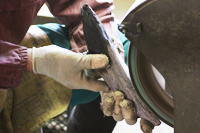
The specialists shave off the surface of "Arabushi" to remove fat.
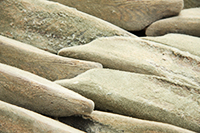
After the water is removed, good mold bacteria are applied to bring out the flavor and to preserve. The mold starts growing in the first several weeks. Fillets go through the process of "sun dry and mold application" repeatedly for few months. Finally, "Honkarebushi" is created.
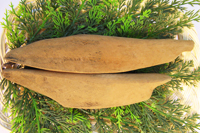 The process up to this point makes "Honkarebushi"
The process up to this point makes "Honkarebushi"
The water content of "Honkarebushi" is as little as 15%.
When two pieces of "Honkarebushi" is hit together, they make beautiful dry and resonating sound.
When you cut through this ultimate "Honkarebushi", it will reveal the beautiful Ruby like inside color.
This working bacteria is called "Kouji" in Japan and has a deep root in the Japanese food culture. "Shoyu" or soy sauce is also a food product made with a "Kouji" like bacteria. The purely cultivated "Koji" bacteria that is used on "Katsuobushi" to create MAKURAZAKI HONKAREBUSHI is also a good "Koji" bacteria called Eurotium herbariorum. Several unique benefits are realized when the mold is applied.
It secretes Protease, Proteolytic enzyme, and builds up the "Umami" components.
"Dashi" from "Katsuobushi" is an animal product in nature, but has no fat or oil found on surface. That's also a work of good bacteria. When mold grows on "Katsuobushi", it secretes Lipase, Lipolytic enzyme, and it breaks down the fat. While fat is found on surface of western or Chinese stock made with beef, pork, chicken or seafood, "Katsuobushi" contains almost no fat. This working mold is what makes the "Katsuobushi" healthy and gives the delicate flavor.
Works of Lipase and Protease give the unique "Katsuobushi" aroma without any fishiness.
Secretion of anti-oxidants protects the exposed surface of "Katsuobushi" from Oxygen when it is kept as a whole.
Delicious "Dashi" made with "Katsuobushi" is the key to all dishes. This versatile stock can be used in various cuisines, not only for "Washoku".
Listed below are the directions on how to make "Dashi" using "Kezuribushi"(=shaved "Katsuobushi"). Have ready 30 grams of "Kezuribushi" and one liter of water.
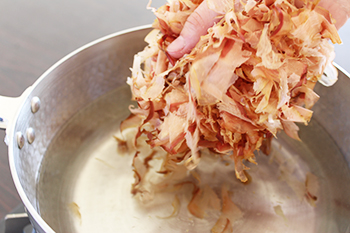
1. Bring one liter of water* to a boil in a pan. Place 30 grams of "Kezuribushi" in the pan.
Immediately turn off the heat.
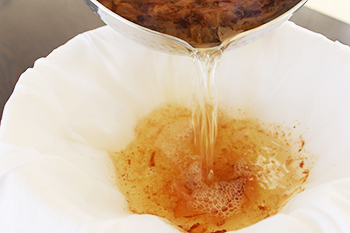
2. The "Kezuribushi" will soon sing to the bottom of the pan. Once it does, strain the liquid through a cloth or scoop up the "Kezuribushi" with a fine sieve.
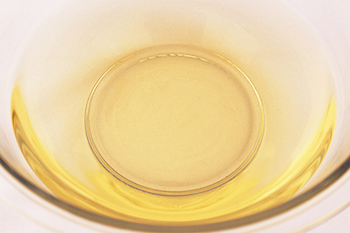
3. You now have the delicious "Dashi".
When you buy "Katsuobushi" and want to keep it for a long time, you should be careful to protect it against mold(other than the desirable type) and insects. "Katsuobushi" should be sealed in an airtight package and stored in a refrigerator.
When you buy "Kezuribushi"(=shaved "Katsuobushi") and once its bag is opened, you should remove the air from the bag, seal it and store in a refrigerator. In the case that the bag size is small, it is recommended to use all the contents at one time.
The point here is that if you leave "Katsuobushi" or an opened bag of "Kezuribushi"(= shaved "Katsuobushi"), it will oxidize by exposure to air and its aroma will deteriorate. Please be careful about this concern.
© Japan Katsuobushi Association